Chen Ding
Tony
Prompt-Free Conditional Diffusion for Multi-object Image Augmentation
Jul 08, 2025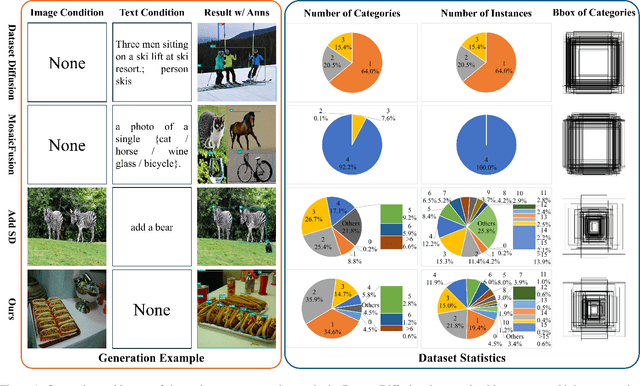
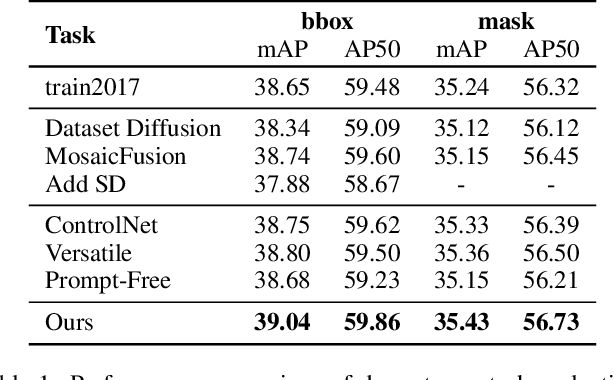
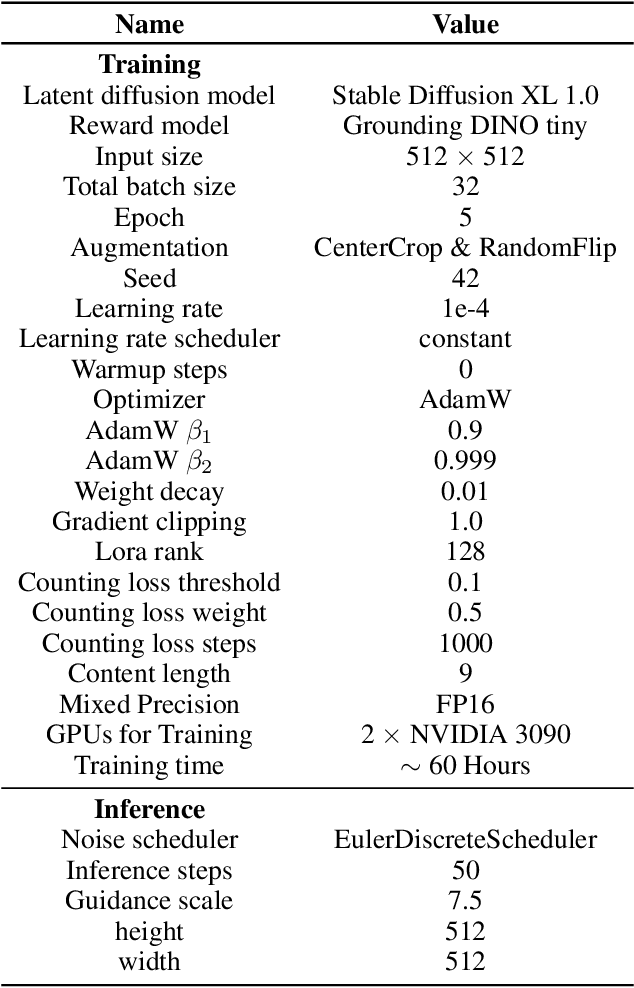
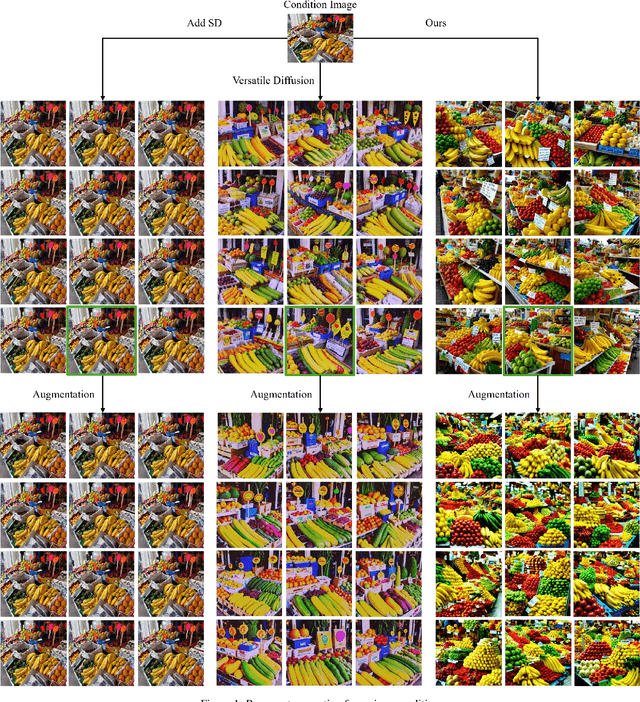
Abstract:Diffusion models has underpinned much recent advances of dataset augmentation in various computer vision tasks. However, when involving generating multi-object images as real scenarios, most existing methods either rely entirely on text condition, resulting in a deviation between the generated objects and the original data, or rely too much on the original images, resulting in a lack of diversity in the generated images, which is of limited help to downstream tasks. To mitigate both problems with one stone, we propose a prompt-free conditional diffusion framework for multi-object image augmentation. Specifically, we introduce a local-global semantic fusion strategy to extract semantics from images to replace text, and inject knowledge into the diffusion model through LoRA to alleviate the category deviation between the original model and the target dataset. In addition, we design a reward model based counting loss to assist the traditional reconstruction loss for model training. By constraining the object counts of each category instead of pixel-by-pixel constraints, bridging the quantity deviation between the generated data and the original data while improving the diversity of the generated data. Experimental results demonstrate the superiority of the proposed method over several representative state-of-the-art baselines and showcase strong downstream task gain and out-of-domain generalization capabilities. Code is available at \href{https://github.com/00why00/PFCD}{here}.
Fake News Detection: Comparative Evaluation of BERT-like Models and Large Language Models with Generative AI-Annotated Data
Dec 18, 2024



Abstract:Fake news poses a significant threat to public opinion and social stability in modern society. This study presents a comparative evaluation of BERT-like encoder-only models and autoregressive decoder-only large language models (LLMs) for fake news detection. We introduce a dataset of news articles labeled with GPT-4 assistance (an AI-labeling method) and verified by human experts to ensure reliability. Both BERT-like encoder-only models and LLMs were fine-tuned on this dataset. Additionally, we developed an instruction-tuned LLM approach with majority voting during inference for label generation. Our analysis reveals that BERT-like models generally outperform LLMs in classification tasks, while LLMs demonstrate superior robustness against text perturbations. Compared to weak labels (distant supervision) data, the results show that AI labels with human supervision achieve better classification results. This study highlights the effectiveness of combining AI-based annotation with human oversight and demonstrates the performance of different families of machine learning models for fake news detection
AI-Powered Algorithm-Centric Quantum Processor Topology Design
Dec 18, 2024Abstract:Quantum computing promises to revolutionize various fields, yet the execution of quantum programs necessitates an effective compilation process. This involves strategically mapping quantum circuits onto the physical qubits of a quantum processor. The qubits' arrangement, or topology, is pivotal to the circuit's performance, a factor that often defies traditional heuristic or manual optimization methods due to its complexity. In this study, we introduce a novel approach leveraging reinforcement learning to dynamically tailor qubit topologies to the unique specifications of individual quantum circuits, guiding algorithm-driven quantum processor topology design for reducing the depth of mapped circuit, which is particularly critical for the output accuracy on noisy quantum processors. Our method marks a significant departure from previous methods that have been constrained to mapping circuits onto a fixed processor topology. Experiments demonstrate that we have achieved notable enhancements in circuit performance, with a minimum of 20\% reduction in circuit depth in 60\% of the cases examined, and a maximum enhancement of up to 46\%. Furthermore, the pronounced benefits of our approach in reducing circuit depth become increasingly evident as the scale of the quantum circuits increases, exhibiting the scalability of our method in terms of problem size. This work advances the co-design of quantum processor architecture and algorithm mapping, offering a promising avenue for future research and development in the field.
Meta-Exploiting Frequency Prior for Cross-Domain Few-Shot Learning
Nov 03, 2024



Abstract:Meta-learning offers a promising avenue for few-shot learning (FSL), enabling models to glean a generalizable feature embedding through episodic training on synthetic FSL tasks in a source domain. Yet, in practical scenarios where the target task diverges from that in the source domain, meta-learning based method is susceptible to over-fitting. To overcome this, we introduce a novel framework, Meta-Exploiting Frequency Prior for Cross-Domain Few-Shot Learning, which is crafted to comprehensively exploit the cross-domain transferable image prior that each image can be decomposed into complementary low-frequency content details and high-frequency robust structural characteristics. Motivated by this insight, we propose to decompose each query image into its high-frequency and low-frequency components, and parallel incorporate them into the feature embedding network to enhance the final category prediction. More importantly, we introduce a feature reconstruction prior and a prediction consistency prior to separately encourage the consistency of the intermediate feature as well as the final category prediction between the original query image and its decomposed frequency components. This allows for collectively guiding the network's meta-learning process with the aim of learning generalizable image feature embeddings, while not introducing any extra computational cost in the inference phase. Our framework establishes new state-of-the-art results on multiple cross-domain few-shot learning benchmarks.
GPT-4o System Card
Oct 25, 2024Abstract:GPT-4o is an autoregressive omni model that accepts as input any combination of text, audio, image, and video, and generates any combination of text, audio, and image outputs. It's trained end-to-end across text, vision, and audio, meaning all inputs and outputs are processed by the same neural network. GPT-4o can respond to audio inputs in as little as 232 milliseconds, with an average of 320 milliseconds, which is similar to human response time in conversation. It matches GPT-4 Turbo performance on text in English and code, with significant improvement on text in non-English languages, while also being much faster and 50\% cheaper in the API. GPT-4o is especially better at vision and audio understanding compared to existing models. In line with our commitment to building AI safely and consistent with our voluntary commitments to the White House, we are sharing the GPT-4o System Card, which includes our Preparedness Framework evaluations. In this System Card, we provide a detailed look at GPT-4o's capabilities, limitations, and safety evaluations across multiple categories, focusing on speech-to-speech while also evaluating text and image capabilities, and measures we've implemented to ensure the model is safe and aligned. We also include third-party assessments on dangerous capabilities, as well as discussion of potential societal impacts of GPT-4o's text and vision capabilities.
SIMRP: Self-Interference Mitigation Using RIS and Phase Shifter Network
Sep 13, 2024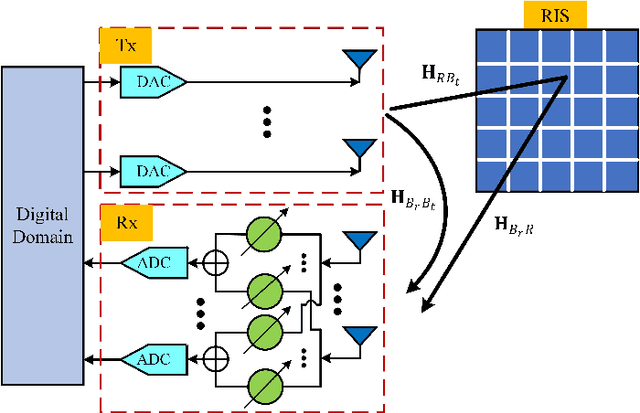
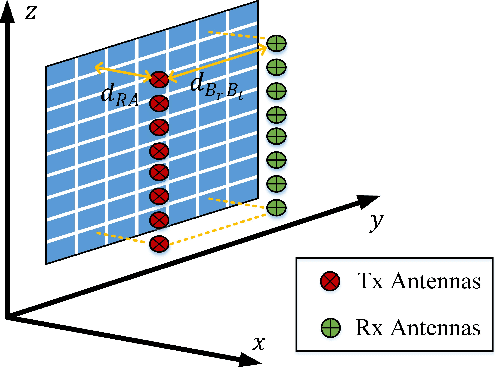


Abstract:Strong self-interference due to the co-located transmitter is the bottleneck for implementing an in-band full-duplex (IBFD) system. If not adequately mitigated, the strong interference can saturate the receiver's analog-digital converters (ADCs) and hence void the digital processing. This paper considers utilizing a reconfigurable intelligent surface (RIS), together with a receiving (Rx) phase shifter network (PSN), to mitigate the strong self-interference through jointly optimizing their phases. This method, named self-interference mitigation using RIS and PSN (SIMRP), can suppress self-interference to avoid ADC saturation effectively and therefore improve the sum rate performance of communication systems, as verified by the simulation studies.
Seed-ASR: Understanding Diverse Speech and Contexts with LLM-based Speech Recognition
Jul 05, 2024



Abstract:Modern automatic speech recognition (ASR) model is required to accurately transcribe diverse speech signals (from different domains, languages, accents, etc) given the specific contextual information in various application scenarios. Classic end-to-end models fused with extra language models perform well, but mainly in data matching scenarios and are gradually approaching a bottleneck. In this work, we introduce Seed-ASR, a large language model (LLM) based speech recognition model. Seed-ASR is developed based on the framework of audio conditioned LLM (AcLLM), leveraging the capabilities of LLMs by inputting continuous speech representations together with contextual information into the LLM. Through stage-wise large-scale training and the elicitation of context-aware capabilities in LLM, Seed-ASR demonstrates significant improvement over end-to-end models on comprehensive evaluation sets, including multiple domains, accents/dialects and languages. Additionally, Seed-ASR can be further deployed to support specific needs in various scenarios without requiring extra language models. Compared to recently released large ASR models, Seed-ASR achieves 10%-40% reduction in word (or character, for Chinese) error rates on Chinese and English public test sets, further demonstrating its powerful performance.
Review-based Recommender Systems: A Survey of Approaches, Challenges and Future Perspectives
May 09, 2024



Abstract:Recommender systems play a pivotal role in helping users navigate an overwhelming selection of products and services. On online platforms, users have the opportunity to share feedback in various modes, including numerical ratings, textual reviews, and likes/dislikes. Traditional recommendation systems rely on users explicit ratings or implicit interactions (e.g. likes, clicks, shares, saves) to learn user preferences and item characteristics. Beyond these numerical ratings, textual reviews provide insights into users fine-grained preferences and item features. Analyzing these reviews is crucial for enhancing the performance and interpretability of personalized recommendation results. In recent years, review-based recommender systems have emerged as a significant sub-field in this domain. In this paper, we provide a comprehensive overview of the developments in review-based recommender systems over recent years, highlighting the importance of reviews in recommender systems, as well as the challenges associated with extracting features from reviews and integrating them into ratings. Specifically, we present a categorization of these systems and summarize the state-of-the-art methods, analyzing their unique features, effectiveness, and limitations. Finally, we propose potential directions for future research, including the integration of multi-modal data, multi-criteria rating information, and ethical considerations.
FAIR Enough: How Can We Develop and Assess a FAIR-Compliant Dataset for Large Language Models' Training?
Jan 23, 2024Abstract:The rapid evolution of Large Language Models (LLMs) underscores the critical importance of ethical considerations and data integrity in AI development, emphasizing the role of FAIR (Findable, Accessible, Interoperable, Reusable) data principles. While these principles have long been a cornerstone of ethical data stewardship, their application in LLM training data is less prevalent, an issue our research aims to address. Our study begins with a review of existing literature, highlighting the significance of FAIR principles in data management for model training. Building on this foundation, we introduce a novel framework that incorporates FAIR principles into the LLM training process. A key aspect of this approach is a comprehensive checklist, designed to assist researchers and developers in consistently applying FAIR data principles throughout the model development lifecycle. The practicality and effectiveness of our framework are demonstrated through a case study that involves creating a FAIR-compliant dataset to detect and reduce biases. This case study not only validates the usefulness of our framework but also establishes new benchmarks for more equitable, transparent, and ethical practices in LLM training. We offer this framework to the community as a means to promote technologically advanced, ethically sound, and socially responsible AI models.
DMC4ML: Data Movement Complexity for Machine Learning
Dec 22, 2023Abstract:The greatest demand for today's computing is machine learning. This paper analyzes three machine learning algorithms: transformers, spatial convolution, and FFT. The analysis is novel in three aspects. First, it measures the cost of memory access on an abstract memory hierarchy, instead of traditional time or space complexity. Second, the analysis is asymptotic and identifies the primary sources of the memory cost. Finally, the result is symbolic, which can be used to select algorithmic parameters such as the group size in grouped query attention for any dimension size and number of heads and the batch size for batched convolution for any image size and kernel size.
 Add to Chrome
Add to Chrome Add to Firefox
Add to Firefox Add to Edge
Add to Edge